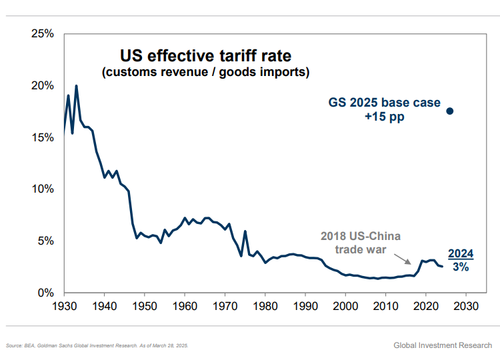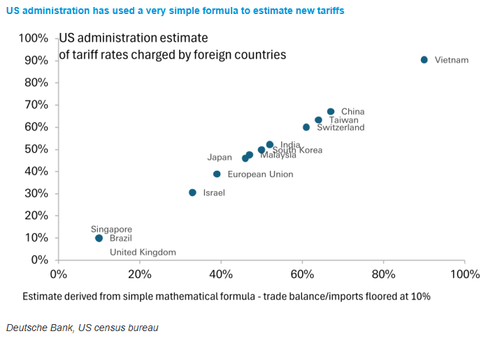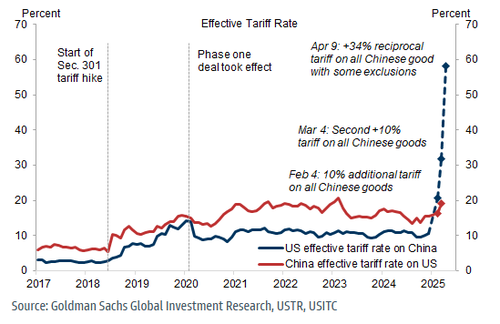"Reign Of Tariffs" Begins: All You Need To Know About Trump's "Reciprocal" Trade War
A lot has taken place over the past 24 hours, so here is our attempt to piece everything together:
Bottom Line: President Trump announced reciprocal tariffs, imposing i) a minimum 10% tariff on all trading partners, and ii) higher rates for countries with large trade surpluses. Among these, China will face a 34% tariff (bringing the total effective tariff to a stunning 60%, see chart below) Japan 24%; South Korea 25%; EU 20%; Vietnam 46%; Taiwan 32%; Vietnam 46%; India 26%; UK, Australia and Brazil 10% (we discussed how these were calculated in a prior post); Canada and Mexico face 25% tariffs on non-USMCA compliant imports.
— Crypto_Maximaliste (@Crypto__Maxi) April 2, 2025
According to Goldman calculations, the “reciprocal” tariff policy President Trump announced would impose a weighted average tariff rate of 18.3%, around 3% higher than the bank expected. However, and this is key, roughly 1/3 of total imports would be exempt, which reduces the impact to a 12.6% increase in the effective tariff rate, and below Goldman's 15% estimate. The bank also estimates this and other tariffs announced year-to-date would raise the US effective tariff rate by 18.8%. The bank also assumes that negotiations with trading partners will lead to somewhat lower “reciprocal” rates than announced, but the prospect for escalation following retaliatory tariffs and a high probability of further sectoral tariffs suggests a risk that the US effective tariff rate rises more than the 15% increase the bank assumed in its economic forecast.
As described earlier, most major trading partners excluding Canada and Mexico would face an additional tariff that equals half the ratio of the US bilateral trade deficit with the country divided by US imports from that country.
This second component would take effect April 9. The fact that these two components were structured separately suggests that the 10% baseline tariff is unlikely to be negotiated down, but that the additional tariff rate could decline following negotiation with trading partners.
Here, it is important to note that Canada and Mexico received better treatment than most (and certainly Goldman) had expected. The executive order continues to exempt USMCA-compliant imports from the 25% tariff on Canada and Mexico. Goldman had expected at least an incremental tariff increase on both countries. The order states that if the exemption ends in the future, USMCA-compliant goods and energy products would receive duty-free treatment while non-compliant products would face a tariff rate of 12%, excluding energy and potash which would be duty-free. This 12% rate might signal the upper bound for tariff rates for Canada and Mexico.
While USMCA was spared, the same can not be said of China, and most Asian trading partners for that matter, who face a much higher tariff than expected. Goldman had expected China imports to be covered by the reciprocal tariff announcement and believed that this would add to the 20% in China-focused tariffs already imposed in February and March. However, the 34% tariff rate announced, which brings the effective rate to almost 60%, was far higher than expected.
The higher tariff rate includes imports from Hong Kong and Macau. Other Asian exporters also face much higher tariff rates, including Vietnam (46%), Taiwan (36%), Thailand (36%), and Indonesia (32%), among others. This appears due to the simplified methodology the US Trade Representative’s office used, described above.
The global tariff takes effect on April 5th, with higher rates starting April 9th. Trump said these levies will remain until the trade deficit threat is resolved. The order includes provisions for adjustments based on retaliatory actions or cooperation from trading partners. Once again, the new tariffs are calculated based on existing trade balances, focusing on countries with large trade surpluses with the US; that strategy marks a departure from previous promises to match the tariff rates and trade barriers imposed by other nations.
US Warning: US Treasury Secretary Scott Bessent advised against retaliatory actions from US trading partners in response to President Trump’s new set of tariffs, suggesting a "wait and see" approach to ongoing trade talks.
Global Autos - Trump's 25% tariff on US auto imports, effective April 2nd, is expected to significantly raise costs and disrupt industry supply chains, potentially impacting both domestic and international car manufacturers, according to Bloomberg.
Metal Tariffs: The US has excluded steel, aluminum, copper and gold from reciprocal tariffs, providing some relief to domestic buyers who are already paying 25% duties on these key metals used in industries like automobiles and appliances.
Pharma Tariffs: The pharmaceutical industry received a temporary reprieve from the sweeping tariffs announced by President Trump, though the relief may be short-lived as the White House plans additional levies on pharmaceutical imports in the future, Bloomberg reports.
US-China: Trump signed an Executive Order ending duty-free deminimis treatment for low-value goods from China and Hong Kong, effective May 2nd (very negative for dropshippers like Temu and Shein). Goods valued at or under $800 will now be subject to duties, with postal items facing a 30% duty or $25/item, increasing to $50 after June 1st.
Federal Reserve: The tariffs imposed by President Trump create a challenging environment for the Fed, complicating efforts to control inflation and prevent a recession. Bloomberg said it might lead to a cautious approach by the central bank as it monitors the economic impact before taking further action. Money markets are discounting three rate cuts from the FOMC this year, with 83bps of cuts priced (implying three full reductions and a decent chance of a fourth). Morgan Stanley, however, leaned back on this, with the bank scrapping its call for a June Fed cut after Trump's tariff announcement, as a result of "tariff-induced inflation," and now sees the FOMC on hold until next March. MS said that if tariffs persist, US economic growth may suffer, with downside risks increasing. Effective tariffs could reach 22% versus 3% at the year's start, raising inflation risks and keeping the Fed from cutting rates in June. That said, it notes that legal challenges under IEEPA remain uncertain. MS recommends positioning for lower Treasury yields and a stronger JPY.
Reactions:
- China has slammed the "unilateral bullying" tariffs, warning it would retaliate
- A Senior EU Official said EU Members are set to vote on April 9 on countermeasures to US steel and aluminium tariffs.
- Meanwhile, Germany and France push for a more aggressive tariff response, advocating for a forceful retaliation that could strengthen the EU's negotiating power, via Bloomberg.
- Elsewhere, Spanish PM Sanchez said they have asked the European Commission to reinforce trade links with the rest of the world; Europe needs to deploy a package of counter-tariffs, other measures, responding to US tariffs with a EUR 14.1 bln plan to protect the Spanish economy.
- Australian PM said they will not impose reciprocal tariffs
Stock Impact: Barclays sees potential relief for ALLE, CARR, ETN, HUBB, Lll, NVT, RRX, and VRT due to limited China imports and significant Mexico imports. PNR has high Mexico exposure and moderate China exposure. They favour CARR, Lll, and PNR for their consumer/early-cycle exposure, solid balance sheets, and pricing power. Conversely, SWK, KMT, FTV, and IR face mixed or negative impacts due to substantial Chinese imports, with SWK most at risk due to high leverage and weak pricing power. Barclays said that if trade barriers rise, recession fears may grow, but it notes that the Ml sector typically performs in line with the S&P during downturns and outperforms post-recession.
Tech Impact: Wedbush said that the Trump tariff announcement was "worse than the worst case scenario" for Wall Street; Wedbush said tech stocks like Apple (AAPL) and Nvidia (NVDA) will face "major pressure" on the announcement, amid worries about demand destruction and supply chains. Meanwhile, Citi estimates the tariff announcements will drive a 9% negative impact to Apple's total gross margins as a result of the 34% reciprocal tariff rate, given it has 90% of its manufacturing in China (Citi kept AAPL at a Buy rating, with a $275 PT).
US-Canada:
- The Republican-led Senate voted 51-48 to reject President Trump’s national emergency declaration aimed at imposing 25% tariffs on Canadian imports.
- This rare rebuke of Trump’s trade agenda occurred shortly after he unveiled plans for additional tariffs on various products, Politico reports.
How will Europe respond?
- Goldman believes that the EU will design its trade policy retaliation following three main criteria: in “value terms” against product-specific tariffs (steel, aluminium, critical imports and auto), in “tariff rate terms” to the broader reciprocal tariffs that we expect on 2 April, and on services thanks to the new policy instruments.
- The response in “value terms” will start from the public lists of US goods targeted for retaliation by the EU. Additional products will be selected depending on how easily US imports can be substituted away in the European economy given trade with other trading partners. The response in “tariff rate terms” will match the across-the-board reciprocal US tariff with a similar tariff in the EU. Goldman expects the EU Commission to prefer imposing tariffs on selected lists of goods as much as possible.
- The EU will facilitate de-escalation, but it is now better equipped than during the 2018-20 trade war to retaliate on imports of US services if the US administration opts for a more aggressive stance. Given the large EU deficit in services, the EU response can range from a more gradual retaliation through the European Digital Services Act (DSA) and the EU Enforcement Regulation, to the novel Anti-Coercion Instrument for a broad set of tariffs on services imports from the US. But if the EU targets US services, we think the DSA would most likely be activated first.
How will China respond?
- Similar to the experience when the previous two 10% tariff increases were imposed on China earlier this year, Goldman thinks the Chinese government is likely to retaliate with some targeted tariffs on US products as well as non-tariff measures like export controls.
- Policymakers will likely continue to resist significant CNY depreciation, instead the government will step up easing measures to offset the additional growth drag from higher tariffs.
- Goldman is not changing its 2025 full-year GDP growth forecast of 4.5% at this time due to better-than-expected Q1 data and increased policy easing expectations, as well as remaining uncertainties regarding whether some of the tariffs could be negotiated down in the coming months. That said, the bank does acknowledge downside risk from slowing global growth after the large, across-the board US tariff increases.
Thoughts around the Goldman floor
Tommy Pinhas – Senior Cash trader
Think over the last couple weeks people have been in de-risk mode, just got back from the US and sentiment was as cautious as I've seen it in years. What that means to me is there is plenty of dry powder when we do finally get some clarity on the outlook to add to favoured names. Todays tariff news definitely worse than expected in particular on Asia imports. Part of what was announced likely to be negotiated down given reciprocal nature, more broadly I expect more domestic stimulus from countries being targetted by the US (china in partic), In the near term 1h earnings will be bad on the cyclical side of the economy, we are seeing institutions shift more defensively and there have been plenty of defensive assets on sale this year in the initial cyclical wave and expect those with credible upside stories to be revisited. On the cyclical side, once the dust settles, clear loser from here is the export channel (watch out shipping) and beneficiaries will be domestic stimulus/ reshoring plays.
Rich Privorotsky - Head of European One Delta Trading
Tariffs worse than feared, Asian / China portion which stands out above all else. Nearly immediate impact so not much time for negotiation. 10% universal tariffs likely a floor. Japan stocks hit hard as the 24% tariff increase there comes as a surprise. Toyota -5% and Japanese banks -7-8%. The market will hope for off ramps but the assumption was Japan would have gotten a lighter touch hence magnitude of overnight moves. Effective tariffs on China at going up nearly 50% (even after exemptions), this is very punitive. The net loser of this is obviously Chinese industry but secondarily is the low end global consumer as the price of goods is likely to increase materially (watch consumer names today).
Probably most surprising of all is the relative outperformance of HSI(-1-2%)/Shcomp (-20bps) and Shprop (+1%) . Domestically focused corporates are somewhat more insulated form trade outperform. Get the impression market must be anticipating some form of broad sweeping domestic stimulus to try to anchor growth. Property loosening is the obvious handbrake and I do wonder if after the dust settles today miners might relatively outperform other cyclicals.
The upshot: Canada and Mexico seem to have been let of the hook with relatively small increases . At end of day the aggregate tariffs in Mexico are pretty small (total tariff increased announce as of April 2 after exemptions: 7.3%). UK at 10% feels like a relative win. Seems better than the worst case for the Autos. Plenty of other exemptions including semis (but not semicap). Bessent once again came out and reiterated his view that tariffs would represent the maximal cap and that negotiations with countries would allow them to be reduced with time. Europe thinking about a stimulus package to counter the effects, the EU proposal is really an extension of implementing the Draghi plan (needs broad EU consent but probably the most bullish thing that could happen from this is that under the threat of duress Europe is forced to join up on infrastructure/joint bond issuance…low chances).
Next few weeks/months we’ll get suggestions of meetings/deals and negotiations with most major trade partners. Think 10% is the floor given universal tariffs and as GIR puts it “While we assume that negotiations with trading partners will lead to somewhat lower “reciprocal” rates than announced today, the prospect for escalation following retaliatory tariffs and a high probability of further sectoral tariffs suggests a risk that the US effective tariff rate rises more than the 15pp increase we assume in our economic forecast” I think the key was to look at how credible the off ramps were. To that I’m not so sure. I took positively the comments form EU and Japan about preparing for negotiations (even the EU said they would not levy countermeasures unless talks failed).
I step back from this and I think the tariffs are worse than the worst case expectations. The China component is very punitive and has the potential to induce a real global growth slowdown. On one hand the trader in me says travel and arrive, but this is worse than what's priced. “The effective U.S. import tax rate has shot to 22% from just 2.5% in 2024” (fitch)….That rate was last seen around 1910. This policy path is an economic fallacy that is resulting in EPS cuts. We might bounce as we try to find the silver linings/hope for negotiation( Japan probably where I'd start) but in US numbers too high/multiples too high and hard to believe that 50% China tariffs were in the price.
Nikhil Choraria - Head of European Interest Rate Products Trading
I don't see how this anything but inflationary for the US. So inflationary such that it can limit the Fed's ability to cut. In the US’s case you also have potential fiscal in which case I don't think the Fed can do much, dare I say anything at all. Think about the next consumer inflation survey...what will be the number? 5%? 6%? Once the dust settles, I think US rates should be higher in yield, not lower. Europe will have to retaliate with tariffs and some combination of loans to companies. In addition the EU may need to tariff other areas to protect the local industries that get hurt. . I think this will be more inflationary for the EU than the market prices. 5y HICP (and possibly RPI?) energy hedged should be going up. The ECB will have a more MPC like dilemma now to work through w.r.t setting policy. Broadly I remind myself, stagflation increases prices at the expense of volumes, and so is bad for earnings, forces wider deficits and monetary policy has to be carefully calibrated to the fiscal response and so will vary in each region => more divergence and the local story matters.
Vitali Meschoulam - Head of the Emerging Markets Strats
Despite calling these reciprocal tariffs, they do not seem to be calculated on tariff or non-tariff measures as they argue. There is clear evidence that they simply targeted the trade deficit by country: (US Trade Deficit/Total Exports by target country to US) / 2…that’s it. Let'ss use Japan as an example (using 2022 data from World bank): US Trade deficit with Japan = $74.14bn, total imports from Japan = $154.5bn. So (74.14/154.5) / 2 = 24%...magic.
More available to pro subscribers.





